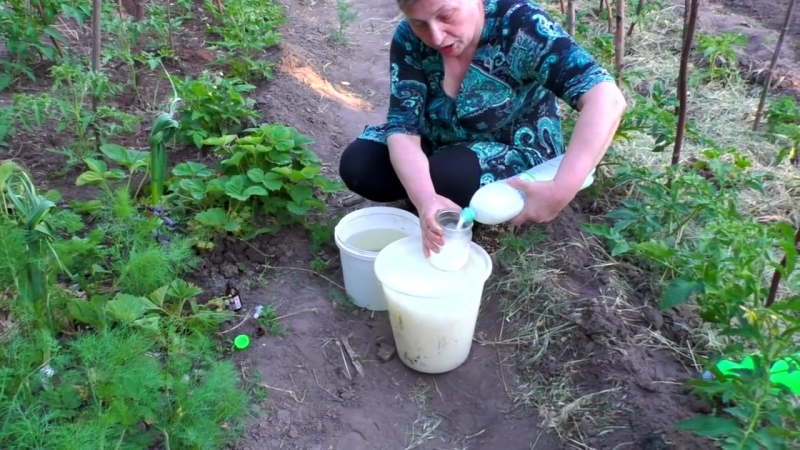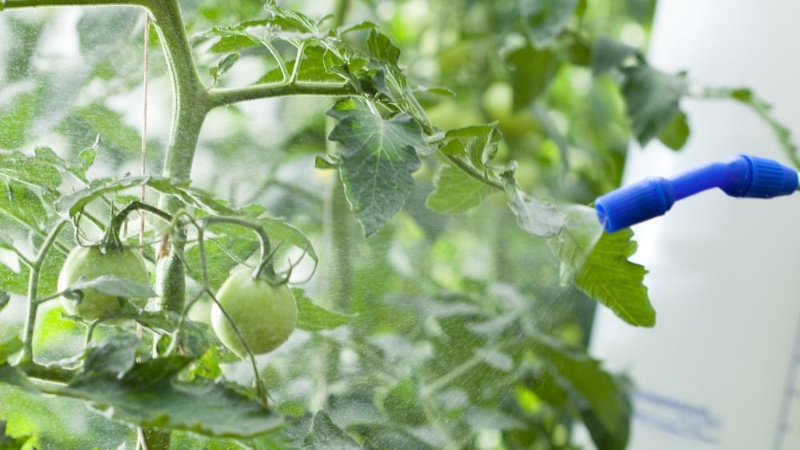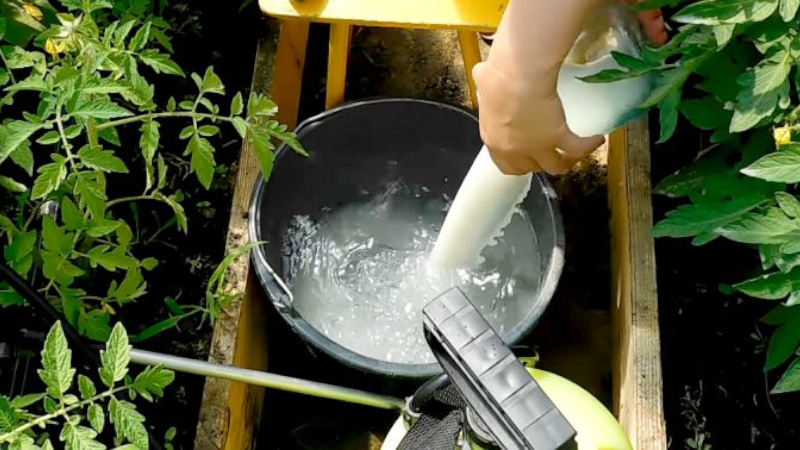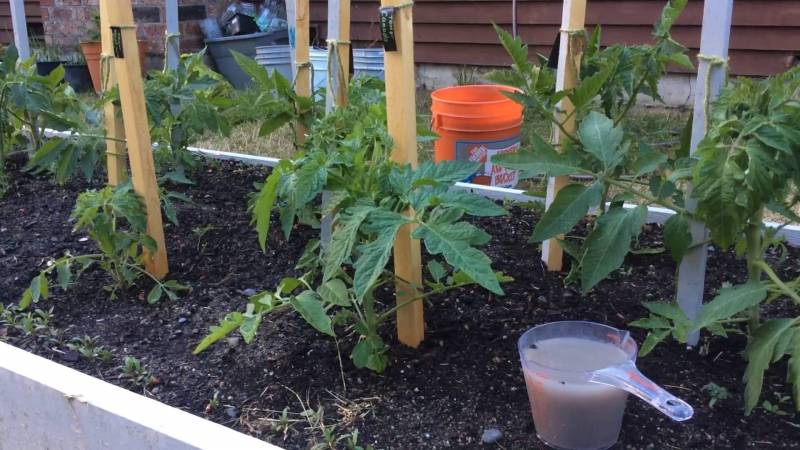Fertilizing tomatoes and cucumbers with whey: the benefits of a fermented milk product for obtaining a bountiful harvest
A rich harvest with minimal costs is the super task of every gardener. For the healthy development of tomatoes and cucumbers, fertilization is necessary. Many vegetable growers do not use chemicals in principle, striving to obtain an environmentally friendly product. For top dressing, natural fertilizers are used, including milk whey.
How useful is feeding with whey for cucumbers and tomatoes, how to properly prepare and use a working solution - you will learn all this from the article.
The content of the article
The use of whey in the garden
Whey is a secondary product obtained during milk processing. It is 93% water, the rest is the substances contained in milk.
Whey is a useful fertilizer for many garden crops. Most often it is used for feeding cucumbers and tomatoes. Both a store-bought product and a self-prepared product made from kefir or sour milk are effective.
The serum can be used in open beds, greenhouses and greenhouses. The product is suitable for processing young and adult plants.

Why feeding with an acidic medium is useful
The serum contains:
- lactose;
- proteins;
- mineral elements;
- amino acids;
- vitamins.
In the garden, this product is highly valued for the content of important amino acids, which are involved in plant growth along with nitrogen, phosphorus and potassium. Lactose protects against pests, monoacid bacteria stop the multiplication of pathogens, the microflora of the product cleans the surface of the leaves from fungi.
Lactic acid inhibits pathogens, promotes greater adhesion of the solution to the leaves. The thin film that forms on the plant protects against the penetration of pathogens and pests.
Can whey be used as fertilizer
The serum is used both for introduction into the soil and foliar processing. The product saturates plants with useful elements necessary for growth, improves their condition, which contributes to an increase in yield.
Important. In addition to tomatoes and cucumbers, the product is used to fertilize squash, squash, pumpkin, cabbage, ferns and roses. The whey is not suitable for peppers and eggplants.
How to prepare a working solution
The product is not used for processing in its pure form. For root processing, the product is diluted with water in a ratio of 1:10. An important condition is that the water temperature must be at room temperature. The solution is poured over the plant under the root and a plot at a distance of 50 cm from it.
For spraying bushes, the concentration of serum is increased; it is diluted with water in a ratio of 1: 3. For better adhesion of the solution, grated or crushed laundry soap is added to it.
The finished solution cannot be stored for more than 2 days, otherwise the fermented liquid will harm the seedlings.
How to treat cucumbers and tomatoes with whey
When and how to water? Cucumbers begin to feed 10 days after planting in the garden. Root and foliar treatments are alternated after 1-2 weeks.
Root processing of tomatoes begins a week after planting in a permanent place. The processing procedure is repeated every 7 days.
For watering one bush of cucumbers and tomatoes, 1 liter of solution is enough. After feeding, be sure to water the plant with clean water to wash off the solution from the leaves.
Stems and leaves are sprayed once every 10 days; for strong plants, the number of procedures is reduced to 1 time per month. Young seedlings can be treated with a serum solution every week.
The last feeding of plants with serum is carried out several weeks before harvest. The procedure strengthens the ovaries.
Greenhouse processing

Experienced gardeners do not recommend using a finely dispersed spray bottle for spraying with a solution of milk whey. Small fractions of curd can clog equipment. The procedure is best done with a spray or sprinkle the plants with a broom.
Important! During treatment, spray not only the leaves, but also the mulch.
Outdoor processing
It is not recommended to process the beds during strong winds and precipitation. The best time to carry out the procedure in open beds is early morning or evening, when there is no strong sunlight. Otherwise, there is a high probability of burning the foliage.
If it rains after treatment, the procedure will need to be repeated. Also, spraying after rainfall will help protect plants from late blight.
What sour product goes well with
Whey is often combined with other folk remedies:
- iodine;
- brilliant green;
- bakery yeast;
- wood ash;
- chicken droppings;
- mowed grass;
- honey.
Yeast is a natural growth stimulant, contains B vitamins, magnesium and active enzymes. It is recommended to combine the bakery product with fertilizers containing potassium, since the yeast helps to wash it out of the soil. It is good to combine yeast with wood ash, as it is rich in magnesium, sulfur, potassium and other elements.
To increase the nitrogen content in the soil, whey is combined with chicken droppings.
The cut grass is a universal product containing all the necessary substances for plant development. During fermentation, it releases a large amount of amino acids and beneficial trace elements.

How to prepare and use functional solution
On the basis of serum, functional solutions are made that allow you to protect against diseases, fertilize the plant and improve its flowering.
Serum with iodine for late blight and powdery mildew
Gardeners use serum for prevention late blight and repelling insects. To do this, add 10 drops of iodine to the working solution. This pharmaceutical preparation increases the metabolic processes in the plant, enhances the nitrogen exchange process, stimulates plant growth and protects against fungal pathologies.
To improve the effect, the drug "Fitosporin" is added to the solution - it increases the resistance of tomatoes to diseases and pests, and also prolongs the fruiting period.
Serum is also used to prevent powdery mildew. Cucumber leaves are treated with the following solution: 10 liters of water, 1 liter of serum and 13 drops of iodine. The procedure is carried out once every 2 weeks.
Concentrated solution with iodine
At the first sign of illness, emergency measures will be needed to save the crop. The usual working solution will not be able to cope with the disease. The roots and stems of plants are treated with a concentrated solution: 0.5 l of serum and 10 drops of iodine.
It is better to use slightly warmed serum to prepare the solution. Diseased plants should be sprayed daily, paying special attention to damaged leaves.
This solution can be used to treat both young seedlings and adult plants. For spraying the fruit, the concentrate is diluted with water.
All-Purpose Vegetable Whey with Ash Recipe
Fertilizer recipe: 10 liters of water will need 2 liters of serum, 10 drops of iodine and 2 tbsp. l. wood ash. It is better to use settled water. The solution is applied under the root or sprinkled with tops.
Healing mixture with the addition of brilliant green
Downy mildew is a dangerous disease that affects cucumbers. You can treat and prevent the disease with the help of such a solution: 1 liter of water, 1 ml of brilliant green, 0.5 liters of serum and 25 g of urea.
Processing is carried out 3 times a season: before and after flowering, as well as in the first days after the formation of ovaries.
Fertilizer with honey during flowering
Whey improves the flowering of tomatoes and cucumbers. To prepare the solution, use: 2 liters of product, 5 tbsp. l. honey, 10 drops of iodine, 1 glass of ash. Mix the ingredients thoroughly and leave to infuse for 2-3 days. The solution is used for foliar treatments, also for soaking seeds.
Important! Spraying during flowering reduces the number of barren flowers.
Pros and cons of whey fertilization

Whey has a number of advantages and disadvantages.
Product pros:
- saturation of the soil with useful trace elements and amino acids;
- increased productivity;
- improving plant development;
- suppression of bacteria and fungi that cause disease;
- treatment of diseases without harm to seedlings;
- use for processing a variety of garden crops;
- acceleration of compost maturation;
- use in the fight against insects.
Disadvantages:
- short-lived effect;
- instability to precipitation.
Serum is short-lived, so it will need to be processed regularly.
Disease prevention
Milk whey not only fertilizes the soil, but also helps to destroy dangerous pathogens that cause disease.
Experienced gardeners use it against such diseases:
- late blight;
- powdery mildew;
- rust;
- fusarium;
- scab;
- leaf spot.
Preventive treatments are carried out 2-3 times a month. Remove dry leaves and rotten stems before the procedure. For spraying, use a solution of whey diluted with water in a ratio of 1: 3.
Insect protection

Serum is loved by insects, so it is used to make traps. Undiluted product is poured into a small container by a third and left in the beds overnight. In the morning, the trapped insects are destroyed.
The product will get rid of such insects:
- aphid;
- onion fly;
- cruciferous flea;
- caterpillars;
- moth.
Precautions
It is important to maintain proper ground balance when using whey. If applied abundantly, there is a risk of lowering the soil pH, which will negatively affect plant health.
Undiluted product can cause burns to leaves and roots. A solution is used to treat the plants.
Serum is a safe product for humans. However, while using it, you should be careful for people who are allergic to dairy products.
Reviews
Valentina, Zhukovsky: “Milk whey is an irreplaceable product in the country. There is little use from the store, I use natural milk from the village. This serum contains many valuable trace elements for plants. "
Artem, Krasnodar: “Tomatoes and cucumbers grow well on whey. I use it to feed plants at the root. I dilute the product with water in a ratio of 1: 8 ".
Natalia, Ufa: “The serum helped get rid of aphids in just 2 sprays. There was a break of 10 days between the procedures. Iodine was added to the solution. The pests left the site, and the plants themselves did not suffer. "
Conclusion
Every gardener encounters diseases and pests from time to time. A simple and affordable tool will help to cope with them - milk whey. This product is absolutely safe for humans and plants. But it is detrimental to pathogens that destroy young ovaries and fruits.
A solution with serum can be fed to seedlings for quick adaptation after planting in the garden.Regular processing will enhance plant growth, increase yields, protect against diseases, and saturate the soil with useful microelements.
Thank you very much for the article. I have never used it. This year I will definitely apply. I made a summary so as not to miss anything.
We are glad that it came in handy 🙂 Have a good harvest!